Revision of the Megasoma (Megasoma) gyas (Jablonsky in Herbst, 1785) species group (Coleoptera, Scarabaeidae, Dynastinae)
- PMID: 33343214
- PMCID: PMC7723882
- DOI: 10.3897/zookeys.999.53130
Revision of the Megasoma (Megasoma) gyas (Jablonsky in Herbst, 1785) species group (Coleoptera, Scarabaeidae, Dynastinae)
Abstract
The taxa of the genus Megasoma Kirby, 1825 (Coleoptera, Scarabaeidae, Dynastinae) related to M. gyas (Jablonsky in Herbst, 1785) are revised. Megasoma (M.) gyas is recognized as a monotypic species restricted to the Caatinga biome of northeastern Brazil. Megasoma gyas rumbucheri Fischer, 1968, is considered as a new synonym of M. gyas. The "long-horned M. gyas" is recognized as a separate polytypic species M. (M.) typhon (Olivier, 1789) with the nominative subspecies occurring through the Mata Atlântica biome of Brazil, from Bahia to São Paulo states and M. (M.) typhon prandii Milani, 2008 restricted to a small area in the state of Santa Catarina, South Brazil. Megasoma gyas porioni Nagai is considered as a new synonym of M. typhon typhon. The "short-horned M. gyas" occurring in Minas Gerais, São Paulo, and southwestern Bahia, is recognized as a separate new species and described as M. (M.) hyperionsp. nov. The paper includes an historical research and the redescriptions of the other nominal species of the genus. Distribution maps and a key to species in the M. (M.) gyas species group (males and females) are also provided.
Keywords: Scarabaeoidea; Cerrado; Neotropical region; South America; new species.
Massimo Prandi, Paschoal C. Grossi, Fernando Z. Vaz-de-Mello.
Figures

























References
-
- Alcantara-Rodriguez M, Françozo M, Andel T van. (2019) Plant Knowledge in the Historia Naturalis Brasiliae (1648): retentions of Seventeenth-Century Plant Use in Brazil. Economic Botany 20: 1–15. 10.1007/s12231-019-09469-w - DOI
-
- Anderson C. (2019) The Old Indies at the French Court. Early Modern Low Countries 3: E3259. 10.18352/emlc.89 - DOI
-
- Antunes AZ, Rapp de Eston M, Rodrigues dos Santos AM. (2007) O Escaravellho Megasoma gyas (Herbst, 1775), Espécie Ameaçada de Extinção, No Parque Estadual Carlos Botelho, Sete Barras – SP. Revista do Instituto Florestal São Paulo 19: 129–135.
-
- Beserra Nobre CE, Bezerra Souza T, Vieira Nunes R, Avello Nicola P, Machado Pereira LC. (2014) A new distribution record of the threatened Megasoma gyas rumbucheri Fisher, 1968 (Coleoptera: Scarabaeidae: Dynastinae) Northward to the Rio São Francisco, Pernambuco, Brazil. The Coleopterist Bulletin 68: 762–764. 10.1649/0010-065X-68.4.762 - DOI
-
- Boeseman M, Holthuis LB, Hoogmoed MS, Smeenk C. (1990) Seventeenth century drawings of Brazilian animals in Leningrad. Zoologische Verhandelingen 267: 1–189.
LinkOut - more resources
Full Text Sources
